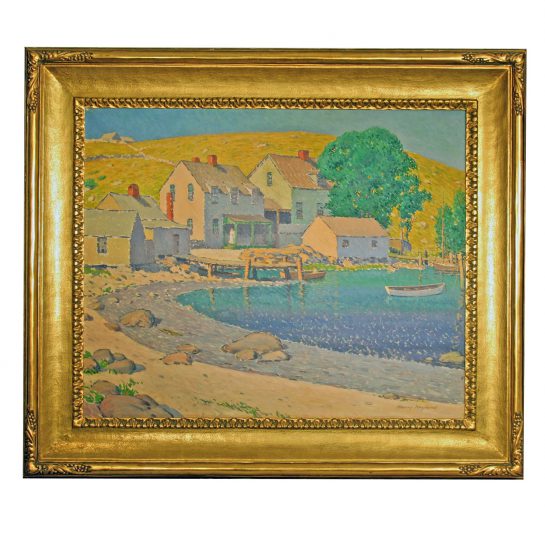Harry A. Neyland (1877-1958) American, active Massachusetts
SOLD
View of Houses in Cuttyhunk, Massachusetts
Oil on canvas
35 ¼” x 41 ¾” framed
Condition: Excellent condition, in signed Carrig-Rohane frame
Harry A. Neyland was born in McKean, Pennsylvania in 1877. After attending the Zanerian Art College in Columbus, Ohio he continued his studies at New York’s Pratt Institute, the Art Student’s League and the Academie Julian in Paris. By 1911, Neyland was living in New Bedford.
The artist continued to live in and around New Bedford for the rest of his life. In addition to New Bedford, Neyland also lived in Dartmouth, South Dartmouth and Padanaram. He commuted to his studio on Cuttyhunk Island for years but had to abandon it after the devastating hurricane of 1938 .
This painting probably depicts Cuttyhunk where Neyland maintained a studio for so many years. The strong blocks of color recall the work of fellow painter, teacher and print-maker Arthur Wesley Dow. Dow was instrumental in disseminating ideas about Notan, a Japanese aesthetic philosophy based on composition, color and line. It influenced the American Arts & Crafts movement at the end of the 19th century and the beginning of the 20th century. The bold colors and forms found in this painting are similar to Dow’s Japanese-inspired prints and paintings as well as a great deal of pottery that was being produced on the East Coast and in the Mid-West.
The frame on this Neyland painting is both noteworthy and desirable. This signed Carrig-Rohane frame is a fine Art & Crafts object. In 1903 the artist Herman Dudley Murphy joined forces with his friends Walfred Thulin and Charles Prendergast to create quality hand-carved, gold leaf frames for paintings. In 1911 it became the Thulin-Murphy Company and in 1913 they began using the Carrig-Rohane name.
Literature: Wilner, Eli. The Gilded Edge: The Art of the Frame. San Francisco: Chronicle Books, 2000. p. 64-73.
The Vose Family became involved sometime between 1915 and 1917. These frames are identified by the deep red back on all the frames and the signature of the carver and date produced. They are also numbered. Because of the Vose inscription on the back of the frame as well as the higher work order number, the date of the frame is probably after 1917.
Item ID: WoA-AMP-OC 463
